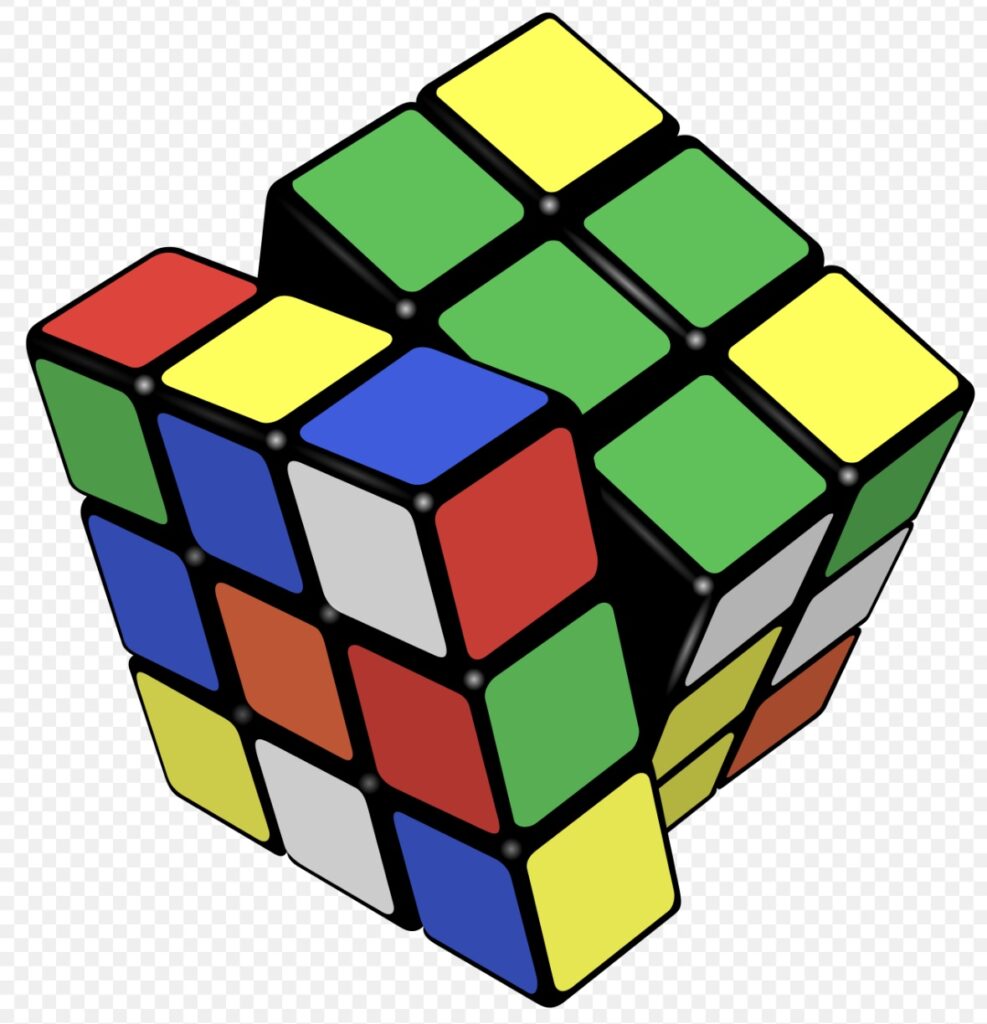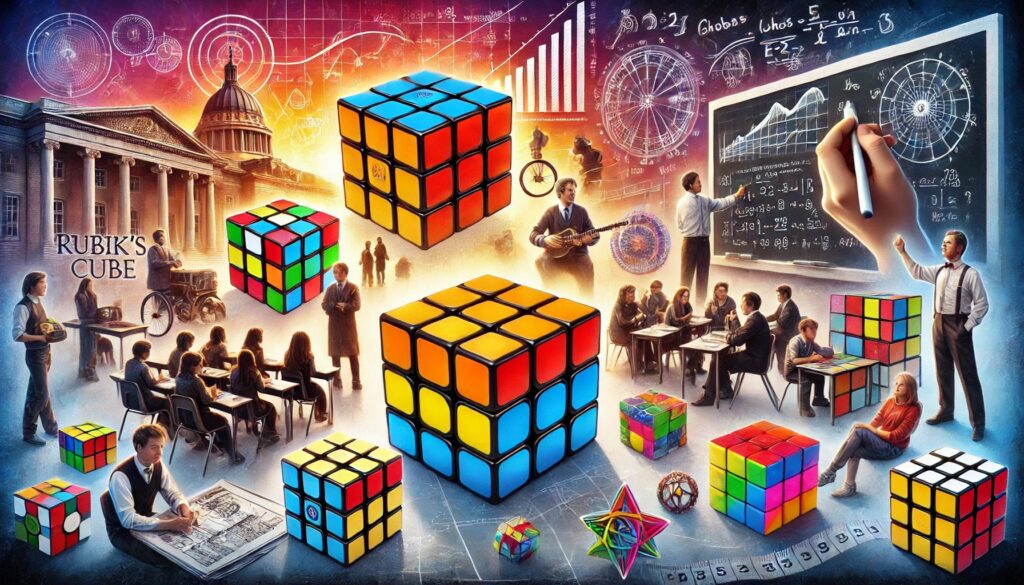Gemini:
The Rubik’s Cube is a 3-D combination puzzle invented in 1974 by Hungarian sculptor and professor of architecture Ernő Rubik. Originally called the Magic Cube, each of the six faces is covered by nine stickers, each of one of six solid colors: white, red, blue, orange, green, and yellow. An internal pivot mechanism enables each face to turn independently, thus mixing up the colors. For the puzzle to be solved, each face must be returned to have only one color.
The Rubik’s Cube quickly gained popularity in the 1980s, becoming a global phenomenon and cultural icon. Its appeal lies in its simple yet challenging nature, captivating people of all ages and backgrounds. The cube’s popularity has led to the development of a competitive sport called speedcubing, where participants race to solve the cube in the shortest possible time.
The Rubik’s Cube’s cultural impact extends beyond its status as a puzzle. It has appeared in numerous films, television shows, and music videos, solidifying its place in popular culture. Moreover, it has been used as a teaching tool in various educational settings, promoting problem-solving skills and spatial reasoning.
Here are some key aspects of the Rubik’s Cube culture phenomenon:
- Speedcubing: A competitive sport where participants solve the cube at incredible speeds, with world records constantly being broken.
- Algorithms: Specific sequences of moves used to solve the cube, developed and shared by enthusiasts.
- Communities: Online and offline communities where cubers connect, share tips, and compete.
- Variations: Numerous variations of the cube have been created, offering new challenges and complexities.
- Symbol of intelligence: The Rubik’s Cube is often associated with intelligence and problem-solving abilities.
Overall, the Rubik’s Cube is more than just a puzzle. It is a cultural phenomenon that has captivated millions of people worldwide, inspiring creativity, competition, and community. Its enduring popularity is a testament to its unique appeal and the timeless joy it brings to those who dare to solve it.

ChatGPT:
Celebrating 50 Years of the Rubik’s Cube: A Comprehensive Overview
🎉 Introduction
In January, the Moscone Center in San Francisco hosted a special event to celebrate the 50th anniversary of the Rubik’s Cube. Organized by Tomas Rokicki, a retired programmer and cubing enthusiast, the event featured Erno Rubik, the Cube’s inventor, participating via videoconference from Spain. This event was part of a larger math conference dedicated to “serious recreational mathematics.”
🧩 The Origins of the Rubik’s Cube
Erno Rubik, a Hungarian architect and professor, invented the Rubik’s Cube in 1974 while preparing a course on descriptive geometry. He was particularly intrigued by the cube while exploring the five Platonic solids. Initially, Rubik did not realize he was creating a puzzle; he was more focused on understanding the structure. By July 1974, he had solved the Cube for the first time, leading to the submission of a patent in January 1975. By the end of 1977, the “Magic Cube” was available in Hungarian toy stores, and it soon became a global sensation.
📈 Global Spread and Cultural Impact
David Singmaster, a mathematician, played a significant role in popularizing the Cube outside Hungary. His book “Notes on Rubik’s ‘Magic Cube’” provided a systematic notation for solving the Cube and introduced many to the puzzle. The Cube quickly became a cultural phenomenon, with the term “cubitis magikia” coined to describe the obsession with solving it. By 1981, the Cube was immensely popular worldwide, but its craze waned by 1982. However, the advent of the internet in the 1990s revived interest, leading to the Cube’s sustained popularity. In 2023, Spin Master, the company that owns the Rubik’s brand, sold 7.4 million units globally.
💡 Philosophical Approach and Solving Methods
During the event, Rubik shared his philosophical approach to cubing. He preferred the method of understanding over following algorithms. He recounted how he solved the Cube using a “corners-first” method. Tomas Rokicki, on the other hand, emphasized the importance of discovering one’s own solving strategy, advocating for a more personal and exploratory approach to cubing.
📚 Learning and Exploration
New cubers often learn through YouTube tutorials, but Rokicki encourages a more traditional method: exploring and discovering a solution independently, even if it takes weeks or months. This approach not only fosters deeper understanding but also connects solvers to the philosophical roots of the Cube’s creation.
📊 Mathematical Complexity
The Rubik’s Cube’s complexity is part of its charm. It consists of 20 smaller “cubies” and six face-center pieces, which can be scrambled into over 43 quintillion possible combinations. This complexity makes the Cube a rich subject for mathematical study, particularly in the field of group theory, which explores the symmetries of geometric objects. The Cube’s 48 symmetries and its vast number of permutations demonstrate its mathematical elegance.
🔢 God’s Number and Computational Achievements
One of the most intriguing mathematical aspects of the Cube is “God’s number,” which is the minimum number of moves required to solve any scrambled Cube position. Tomas Rokicki, with the help of other cubing enthusiasts and significant computing power donated by Google, determined in 2010 that this number is 20. Rokicki continues to research these optimal solutions, using advanced algorithms and substantial computing resources.
🎨 Cultural Influence and Educational Uses
The Rubik’s Cube has permeated various cultural domains. Parisian street artist Invader creates “Rubikcubist” artworks using the Cube. The Cube is also used as an educational tool; Lauren Rose at Bard College incorporates it into her teaching to help students learn mathematical concepts and problem-solving skills. The Cube’s accessibility and engaging nature make it a valuable resource in education.
🎵 Creative Applications
The Cube has also inspired creative applications in music. Italian physicist and composer Maria Mannone developed the “CubeHarmonic,” a musical instrument where each face of the Cube represents different musical chords. This innovative use of the Cube demonstrates its versatility and influence beyond traditional puzzling.
🛠️ Variants and Innovations
The original 3x3x3 Cube has inspired numerous variants, including the 4x4x4 Rubik’s Revenge, the 5x5x5 Professor’s Cube, and even a virtual 256x256x256 version. These variants offer additional layers of complexity and challenge. Innovators like Katsuhiko Okamoto have also created unique versions, such as the hollow Void Cube, which lacks central cubies and interior mechanics.
🧠 Machine Learning and Robotics
The Cube presents an excellent challenge for machine learning and robotics. The problem of solving the Cube efficiently is a task well-suited to these fields, pushing the boundaries of computational problem-solving and artificial intelligence.
🔍 Conclusion
The 50th anniversary celebration of the Rubik’s Cube highlighted its enduring appeal and its significance in both recreational and serious mathematics. From its invention by Erno Rubik to its global cultural impact, the Cube continues to captivate and inspire. Its combination of simplicity and complexity makes it a unique puzzle that bridges fun and serious intellectual pursuit. As Rubik himself noted, the Cube brings people together and fosters a sense of hope and connection.
Key Points Recap
- Origins: Erno Rubik invented the Cube in 1974 while exploring geometry.
- Anniversary Event: Celebrated at the Moscone Center with Rubik speaking via videoconference.
- Philosophical Approach: Rubik and Rokicki discussed personal and philosophical methods of solving the Cube.
- Global Spread: The Cube became a global sensation in the 1980s and remains popular.
- Mathematical Depth: The Cube’s permutations and symmetries are explored in group theory.
- God’s Number: Determined to be 20 moves by Tomas Rokicki in 2010 with Google’s help.
- Cultural Impact: Influences art, music, and education; used by artists and educators.
- Variants and Innovations: Many Cube variants exist, offering additional challenges.
- Creative Applications: Inspired musical instruments and artworks, showing its versatility.
- Machine Learning: The Cube is a challenging problem for AI and robotics.
Celebrating 50 Years of the Rubik’s Cube: FAQs
Q: Who invented the Rubik’s Cube and when?
A: Erno Rubik, a Hungarian architect and professor, invented the Rubik’s Cube in 1974.
Q: What was the original purpose of the Rubik’s Cube?
A: The Cube was initially created as a teaching tool for explaining three-dimensional geometry.
Q: How many possible combinations does the Rubik’s Cube have?
A: The Rubik’s Cube can be scrambled into over 43 quintillion possible combinations.
Q: What is “God’s Number” in the context of the Rubik’s Cube?
A: “God’s Number” is the minimum number of moves required to solve any scrambled position of the Cube, which is 20.
Q: How did the Rubik’s Cube become a global phenomenon?
A: The Cube spread globally in the late 1970s and early 1980s, becoming a popular toy and cultural icon.
Q: What role did David Singmaster play in the Cube’s popularity?
A: David Singmaster, a mathematician, popularized the Cube by developing a systematic notation for solving it and publishing guides.
Q: How has the Rubik’s Cube influenced culture and education?
A: The Cube has influenced art, music, and education, being used as a tool to teach mathematical concepts and problem-solving skills.
Q: What are some of the Rubik’s Cube variants that have been created?
A: Variants include the 4x4x4 Rubik’s Revenge, the 5x5x5 Professor’s Cube, and virtual versions like the 256x256x256 Cube.
Q: How is the Rubik’s Cube used in machine learning and robotics?
A: The Cube presents a challenging problem for AI and robotics, pushing the boundaries of computational problem-solving.

